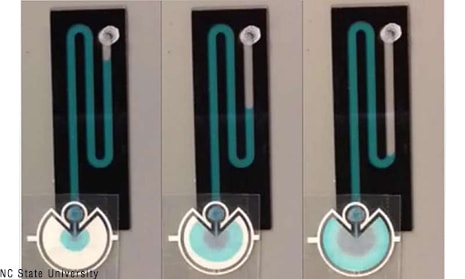Small capillary pumps made from paper able to power portable microfluidic technology
Orange County, CA - March 13th 2017 - Microfluidic technology manages the manipulation of fluids compressed into a volume of one microliter or less. These small, but powerful devices have an array of uses spanning from real-time detection of disease and toxins to complete microenvironmental control for scientific study. This is gadgetry is responsible for a new era of diagnostic technology that will potentially make the bulk of medical tests simpler, inexpensive, and largely more accessible.
Currently the devices use large, external pumps that are programmed for precise yield, but in an effort to increase their portability, biomedical engineering researchers from North Carolina State University and the University of North Carolina at Chapel Hill have developed tiny paper-based pumps to power the portable microfluidic devices.
“One longstanding challenge to the development of portable, real-world microfluidic device technologies has been the need to find a cost-effective way to pump fluids through the device when outside of the lab,” said Glenn Walker, an associate professor in the joint biomedical engineering program at NC State and UNC and co-corresponding author of the study. “Portability is important, because it makes new applications possible, such as diagnostic tools that can be used in the field.”

The new pumps use capillary action, to draw water into the paper’s pores through surface tension, making the liquid’s movement through the device similar to a hydraulic battery. Such methods allow control of the stop and re-start of flow, and the speed and duration the liquid is pushed through the pump by changing its size. This can be altered in two dimensions by cutting the paper out or modified in three dimensions by stacking more pumps, one on top of the other.
“Our system uses pieces of paper that are 125 microns thick, little more than the width of a single hair,” Walker said. “And by changing the shape of the paper, we are able to control how much liquid is pulled through an attached device and how quickly that happens.”
Additionally, the cost of the paper device is less than 10 cents, and with mass-production that number could dwindle to mere pennies. Researchers have filed a patent application on the paper device and are currently looking for partners to collaborate in bringing it to market. The team is confident that the widespread development of this device could have a great impact on the delivery of public health as well as the research sector.
To read their study click here.
Contact Ampronix:

Email: info@ampronix.com
International Sales: +1 949-273-8000
Domestic Sales: 1800-400-7972 for US and Canada
Follow Us:
Share This Article:
View our Product Catalog Online Here
About Ampronix
Ampronix is a renowned authorized master distributor of the medical industry's top brands as well as a world-class manufacturer of innovative technology. Since 1982, Ampronix has been dedicated to meeting the growing needs of the medical community with its extensive product knowledge, outstanding service, and state-of-the-art repair facility. Ampronix prides itself on its ability to offer tailored, one-stop solutions at a faster and more cost-effective rate than other manufacturers. Ampronix is an ISO & ANSI/ESD certified facility. To learn more go here.
Small capillary pumps made from paper able to power portable microfluidic technology Orange County, CA – March 13th 2017 – Microfluidic technology manages the manipulation of fluids compressed into a volume of one microliter or less. These small, but powerful devices have an array of uses spanning from real-time detection of disease and toxins to complete […]



